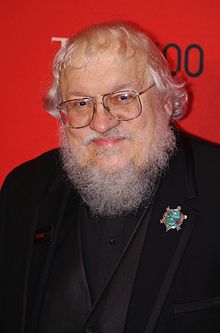 |
| The American Tolkien? |
It is well documented that Tolkien built Middle Earth with Europe in mind. For example, The Shire is meant to be very similar to Tolkien's home in England, and Rivendell to Oxford. The East is an area where danger and war came from. To the south is a warm continent with dark skinned, weak-willed people1. Action was situated on the edge of a larger continent with an ocean to the west and mysterious lands beyond that.
Similarly, it seems that Westeros had a strong influence from North American geography. This was not explicitly intentional by GRRM, like it (somewhat) was for Tolkien. Any of the examples I will discuss below might likely be coincidences. However, taken together, it seems apparent that the geography of the world that the created of the A Song of Ice and Fire series lived in had a large influence on the world he created.
Lets try and document some of the ways that Westeros and North America are similar:
- Both situate themselves by having a large continent to the east reachable by boat, with a largely unexplored ocean to the west.
- Westeros and NA both have large majority, white populations that came from the east, defeating pre-iron age natives by either killing them or forcing them to the margins of habitable land.
- Both have natives with perceived ethic of environmental harmony.
- Both have a dominant, highly organized religion which supplanted native animist traditions.
- Lets assume that the permafrost region of North American can be analogous to the region north of the Wall2. Lets compare how Westeros scales to NA if we assume the Wall is at roughly 60°N latitude, We know the wall is ~300 miles long, so we can scale the rest of the continent from there.3

First the cold, snowy North region of Westeros has a border almost exactly at 49 degrees, right where the US Canada border is.

Second, the political capitol of the realm, filled with villainy and wretched people lies on the east coast on a large river at almost the exact latitude in North America as it does in Westeros.
I would like to emphasis again that I do not think that GRRM planned any of this intentionally. Of course he didn't specifically intend for the border for the North to be at the same spot as the border of Canada. But I think this can be the beginning of a discussion on how geography, mental maps, and our relationship to the physical world influence literature and other creative works.
Both the author and reader have topological and ontological frameworks with which to build the world, and these get expressed by how we interpret and relate to the work. Trying to understand these relationships can help us untie the prejudice and assumptions that we bring to art and the world (see Tolkien example above). I am not a literary critic by training, but I think these are some important concepts to examine.
1. Speaking of racism in these series...I find it interesting that the ASOIAF books have strong depictions of misogyny, violence, and abuse because they represent accurate depictions of the depravity of both that world and our world, but racism is largely missing from the books despite having a racially diverse character base↩Both the author and reader have topological and ontological frameworks with which to build the world, and these get expressed by how we interpret and relate to the work. Trying to understand these relationships can help us untie the prejudice and assumptions that we bring to art and the world (see Tolkien example above). I am not a literary critic by training, but I think these are some important concepts to examine.
2. No real reason to assume this, except to see how interestingly close these regions line up between NA and Westeros. Who knows what kind of patterns drive global ice cover on Planetos.↩
3. For the map nerds: I used a Mercator projection because I had to use some projection for illustrative purposes. It had to be a cylindrical projection because I wanted the wall stretch from more-or-less directly east to west, and I didn't want to have to find a conic projection with a tangent line at 60 degrees. I could have used a Gall-Peter's, I guess, but you don't want me to be that kind of asshole, do you?↩










